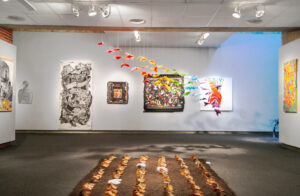
If you were to sit down and think of all the things that are associated with the ongoing pandemic, the word “distance” would be among the first things that come to mind. However, even during this unprecedented time, there seems to be one aspect of life that continues to bring us all together: Art.
Preston McLane, director of Florida State University’s Museum of Fine Arts; and Meredith Lynn, assistant curator and director of galleries at MOFA, recently discussed the role of art museums in the community and welcomed student engagement.
Lynn, who also teaches museum and cultural heritage studies in FSU’s Department of Art History, encouraged students to voice their opinions and share their ideas with them.
“Both Preston and I are always looking for student feedback on what they want to see in the museum, what kinds of conversations do they want to have, what is important to them and we try our best to respond,” she said. “We encourage students to attend museum events or to just come inside and talk with us. We would love to hear about some of the things you are excited by as well as what keeps you up at night. This is often how we take on projects at the museum.”
For instance, “Memento Vitae,” a small selection of works that represent grief and joy, is a flower focused exhibition that debuted on Jan. 11 after Kailea Myrick, a graduate student in the museum and cultural heritage studies program, proposed the exhibit.
McLane shared his initial thoughts and the significance of this exhibition.
“Oh, a museum show with flowers. How anodyne, right? But in fact, it is really powerful. We’ve had positive feedback because of the time in which it was curated, the diverse approaches from the artists, and the thread that we can conceptually weave through individual pieces and integrate into a collection of reflection during this time,” he said.
What is also important, McLane said, is that art museums serve as an intermediary between arts and the community.
“Among the many wonderful things about art and having the privilege of teaching through art is that it is this very effective and sometimes difficult container of meaning. There is a lot of meaning that is invested in the process of creating as well as the objects and materials that were used in the process,” he said.
Although a graduate student was able to get the museum to showcase her idea, Lynn established realistic expectations for student creators.
“The questions that I get asked a lot from young people is, ‘How do I get my art out in public, can you help me get a show, and can you show my art in the museum?’ The answer is usually, no. I cannot just show your art at the museum as that it is just not our mission,” she said.
However, Lynn offered advice that she once received as a young artist that helped her to deal with rejection.
“My mentor told me that you should be rejected by 90% of the things that you apply for. If you are not rejected by 90% of the things that you apply for, you are applying to the wrong things,” she said.
Lynn went on to provide final words of advice to aspiring creators.
“You have the power to create what you want to see in the world. So, if you are 22 and you want to put your artwork out there but there is no place that is serving you and your community or the art that you want to see out in the world, then make it yourself. Turn your living room into a gallery, invite your friends over, and make an Instagram account.”